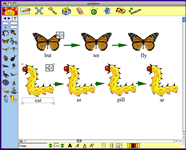Nonfiction Read-Aloud
Add nonfiction to your real-aloud activities. If most of your real-alouds are fiction, consider infusing nonfiction selections. From space exploration to Colonial days, read-alouds can bring the real-world to life for young people. It also introduced children to areas they may not self-select.
Approaches to Nonfiction Read-Aloud
Nonfiction read-aloud is an excellent way to model nonfiction reading.
- Pre-reading Strategies
- Create a KWL chart focusing on accessing prior knowledge and questioning
- Discuss the Cover
- Talk about the Table of Contents
- Scan the book and discuss the visuals
- Generate questions
- Make predictions
- Make Reading Interactive. Consider ways that you can bring the text alive for young people
- Use vocal expression to liven the text.
- Bring in associated visuals
- Search the web for answers to quick questions
- Use the book's glossary
- Use the dictionary to define words
- Keep a concept map of information and ideas
- Create sketches of interesting element
- Keep a timeline of key events
- Think Alouds. Help young people understand how to read nonfiction through a think-aloud approach. Demonstrate how to approach unknown words and how to draw connections among content. Use prompts such as:
- I don't understand this word, so I'm going to re-read this section.
- I'm thinking about a time when...
- This section is like when...
- I'm picturing in my mind...
- I'm connecting this to that...
- This picture helps me...
- I'm guessing/predicting/inferring that...
- I think that this means...
- An example of this would be...
- I think this section about about...
- The big idea is...
- After Reading
- Complete the KWL chart
- Discuss the main idea
- Summarize
- Create a visual picture of the book
Here are a few examples of effective nonfiction real-aloud. Use Google Preview to see if the written style works for real-aloud.
Primary Grades
Explore the topic of music, listen to music, and read about music. Use websites to reinforce music themes.
- Ah, Music! (Google Limited Preview) by Aliki
- Music Is by Lloyd Moss
- Rap a Tap Tap: Here's Bojangles - Think of That! by Leo and Diane Dillon
- Music Websites
- DSO Kids - Read directions for making instruments
- KidsZone from New York Philharmonic - Explore music, instruments, and composition. Read about composers..
- Song Time from BBC - Make music and sing along.
- BBC Music and Songs
- Use Kidspiration, paint or presentation Software to make Beat Pictures. Use stamps to show the syllables in words. Use the microphone to pronounce the word and clap with each syllable.
- Learn more at Music-Learning with a Beat in Literature Links (Google Limited Preview) by Linda Lab
Other Primary Literature for Nonfiction Real-Aloud
- Diego by Jeanette Winter
- Growing Vegetable Soup by Lois Ehlert
- Kites Sail High by Ruth Heller
- Home Run by Robert Burleigh
- Look to the North: A World Pup Diary by Jean Craighead George
- A River Ran Wild by Lynn Cherry
- This it the Way We Eat Our Lunch: A Book About Children Around the World by Edith Baer
Intermediate/Middle Grades
Biographies make great read-alouds. Look for biographies that have an interesting writing style for spoken word activities.
- Small Steps: The Year I Got Polio (Google Limited Preview) by Peg Kehret. This is a great choice because many children are aware of her popular fiction books on topics such as earthquakes and tornadoes.
- Edgar Allan Poe: A Biography (Google Limited Preview) by MIlton Meltzer. Also, explore his others biographies as well as history books.
- Red Scarf Girl: A Memoir of the Cultural Revolution by Ji-Li Jiang (author website). Explore the Cultural Revolution in China in the 1960s.
- So You Want to by President?
Consider books with short self-contained chapters. It's not necessary to read an entire book. Look for books that contain short chapters that can be read in 5 to 10 minutes. Ask students to keep a journal or sketchbook of their thoughts. Also, consider a poster format. As each person is introduced, ask them to make comparisons. Finally, ask students to select a person to explore in-depth.
- English Standard 7.2.6. Assess the adequacy, accuracy, and appropriateness of the author's evidence to support claims and assertions, noting instances of bias and stereotyping. (Core Standard)
- English Standard 8.2.4. Compare the original text to a summary to determine whether the summary accurately describes the main ideas, includes important details, and conveys the underlying meaning.
React to a persuasive, nonfiction text, such as a letter to the editor, by asking questions that the text leaves unanswered and challenging the author's unsupported opinions. Evaluate the accuracy and appropriateness of the evidence presented in a book, such as Lives of the Writers by Kathleen Krull.
- Lives of the Extraordinary Artists: Masterpieces, Messes (and What the Neighbors Thought) (Google Limited Preview) by Kathleen Krull
- Lives of the Extraordinary Athletes: Thrills, Spills (and What the Neighbors Thought) (Google Limited Preview) by Kathleen Krull
- Lives of the Extraordinary Women: Rulers, Rebels (and What the Neighbors Thought) (Google Limited Preview) by Kathleen Krull
- Lives of the Musicians: Good Times, Bad Times (and What the Neighbors Thought) (Google Limited Preview) by Kathleen Krull
- Lives of the Presidents: Fame, Shame (and What the Neighbors Thought) (Google Limited Preview) by Kathleen Krull
- Lives of the Writers: Comedies and Tragedies(and What the Neighbors Thought) (Google Limited Preview) by Kathleen Krull
 Other Intermediate Literature for Nonfiction Real-Aloud
Other Intermediate Literature for Nonfiction Real-Aloud
- Turn of the Century by Ellen Jackson
- Come Back, Salmon by Molly Cone
- Through My Eyes by Ruby Bridges
- Books by Diane Stanley
- Leonardo da Vinci
- Books by Jean Fritz
- And Then What Happened, Paul Revere?
- Why Don't You Get a Horse, Sam Adams?
Middle School Literature for Nonfiction Real-Aloud
- The Royal Kingdoms of Ghana, Mali, and Songhay (Google Limited Preview) by Pat McKissack and Fredrick McKissack. Also consider other nonfiction works by these authors.
- A Sand County Almanac, and Sketches Here and There (Google Limited Preview) by Aldo Leopold
- Articles from Orion Magazine
Other Middle/High School Literature for Nonfiction Real-Aloud
- Christmas in the Big House, Christmas in the Quarters by Pat McKissack and Fredrick McKissack
- History books by Russell Freedman
- History books by Jim Murphy
- Into the Mummy's Tomb: The Real-Life Discovery of Tutankhamun's Treasures by Nicholas Reeves
- The Case of the Mummified Pigs and Othe Mysteries in Nature by Susan Quinlan
- In My Hands: Memories of a Holocaust Rescuer by Irene Gut Opdyke and Jennifer Armstron
- I Was a Teenage Professional Wrester by Ted Lewin
Guidelines for Nonfiction Read-Aloud Section:
- Focus on topics of interest to children.
- Seek cross-curricular topics that might be overlooked.
- Select interesting text, while avoiding long lists and heavy content.
- Consider books that contain chunks of information or short chapters.
- Limit vocabulary challenges or provide a glossary.
- Check currency and accurate (Pluto is no longer a planet).
- Consider whether the text makes sense without the visuals.
Use read-aloud as a way to build vocabulary.
- What did you like and dislike?
- What did you find strange?
- What did you find interesting?
- What are your questions?
- Where could you find more information?
Book Suggestions from Tony Stead
- All Ages
- Crow! Strange and Wonderful by Laurence Pringle
- In November by Cynthia Rylant
- The Magic School Bus series by Joanna Cole
- My New York by Jacky Jakobsen
- One Tiny Turtle by Nicola Chapman
- Sharks! Strange and Wonderful by Laurence Pringle
- Sky Scrape/City Scape: Poems of City Life by Jane Yolen
- Totally Bizarre. Exploring the Worlds of Unsolved Mysteries by Celia Bland
- What Is My Dog Thinking? What is my Cat Thinking? by Gwen Bailey
- Grades 1-3
- Magic Tree House Series by Will and Mary Poe Osborne
- Sammy Dog Detective by Colleen Stanley Base
- Grades 3-6
- 26 Farimount Avenue by Tomie dePaola
- African Critters by Robert Haas
- The Case of the Mummified Pigs and other Mysteries in Nature by Susan Quinlan
- Egyptology based on diary by Emily Sands
- Joyful Noise: Poems for Two Voices by Paul Fleischman
- When Night Comes by Ron Hirschi
- Voices of Ancient Egypt by Kay Winters



